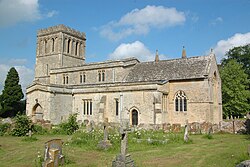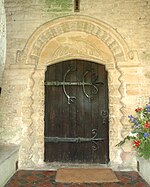Middleton Stoney
- Not to be confused with Stoney Middleton
| Middleton Stoney | |
| Oxfordshire | |
|---|---|
 All Saints, Middleton Stoney | |
| Location | |
| Grid reference: | SP534235 |
| Location: | 51°54’29"N, 1°13’30"W |
| Data | |
| Population: | 331 (2011) |
| Post town: | Bicester |
| Postcode: | OX25 |
| Dialling code: | 01869 |
| Local Government | |
| Council: | Cherwell |
| Parliamentary constituency: |
Banbury |
| Website: | middletonstoney.com |
Middleton Stoney is a village about two and a half miles west of Bicester, in Oxfordshire. The 2011 Census recorded the parish's population as 331.
The eastern boundary of the parish is Gagle Brook, a tributary of the River Ray, and its western boundary is Aves Ditch:[1] this is a pre-Saxon feature and may have been dug as a boundary ditch.
Name
"Middleton" is a common place-name across the British Isles: derived from Old English, it means "middle village". The Domesday Book of 1086 records this particular Middleton as Middeltone. Episcopal registers record it as Mudelingtona in 1209–19 and Middellington in 1251. A document from 1242 included in the Book of Fees records it as Mudelinton.[2]
The earliest known record of the affix "Stoney" is from 1552. It may refer to stone pits in the parish, from which Jurassic Cornbrash limestone was quarried to build dry stone walls.[1] It differentiates the village and parish from Middleton Cheney in Northamptonshire, about twelve miles to the north.
History
The remains of a Roman building from the second century AD, possibly a barn, have been found south-east of the former castle.[3]
In the time of King Edward the Confessor, one Turi held the manor. It was valued at 10 hides.[1]
Middleton Stoney Castle was a motte-and-bailey that was first recorded in 1215. Its remains are east of All Saints' Church[4] and are a Scheduled Ancient Monument.[5]
Middleton Park is a neo-Georgian country house]] designed by Edwin Lutyens and his son Robert: they built it in 1938 for the 9th Earl of Jersey.[3] The house is a Grade I listed building.[6]
The parish's common lands were inclosed at the end of the 17th century.[7] In 1824–25 George Child Villiers, 5th Earl of Jersey had the original village and manor house demolished to make way for him to expand Middleton Park eastwards.[7] The castle mound and All Saints' church remain isolated within the extended park.[7] His wife Sarah Villiers, Countess of Jersey directed the building of new cottages on the edge of the park, each with a rustic porch and a flower garden.[7] These form the nucleus of the current village.[7]
The current village is at the crossroads of two main roads. The north–south road used to be the main road between Oxford and Brackley. The east–west road is the main road between Bicester and Enstone in 1797 this road was made a turnpike'[1] it was disturnpiked in the 19th century.
Parish church
The earliest parts of the Church of England parish church, All Saints are Norman, built in the middle of the 12th century. In about 1190 the chancel arch was inserted and the north aisle and three-bay arcade were added in a transitional style between Norman and Early Gothic. In the 14th century the south aisle and its two-bay arcade were built. The nave has a clerestory that was added in the 15th century.[8]
In 1805 a transeptal mausoleum was added to the north side of the chancel for the Child-Villiers family.
In 1858 the church was restored under the direction of the architect Samuel Sanders Teulon, under whom the west tower was rebuilt and the Jersey mausoleum was Normanised.[9]
In 1860 a 14th-century Gothic font was presented to the church.[8] On its base a 17th-century inscription says This fonte came/from the Kings/chapel in Islipp... and claims that Edward the Confessor was baptised in it.[10] If true, it would be an Anglo-Saxon font that was re-cut and Gothicised in the 14th century: it may have been salvaged from the Saxon chapel of the Royal House of Wessex at Islip, which was damaged in the Civil War in 1645 and demolished in the 1780s.[11]
In 1868 the church was refitted to designs by the Oxford Diocesan architect George Edmund Street, who added a vestry, reredos, choir stalls and new pulpit.[12]
The church is a Grade II* listed building.[10]
Amenities
The village has a pub that used to be called the Eagle and Child. It is now the Jersey Arms, an hotel owned by Shepherd Cox Hotels and operated as a Best Western SureStay Hotel.[13] The village has an Italian restaurant, the Rigoletto.[14]
Middleton Stoney used to have a parish school.[1] The building is now the village hall.
Outside links
| ("Wikimedia Commons" has material about Middleton Stoney) |
References
- ↑ 1.0 1.1 1.2 1.3 1.4 Lobel 1959, pp. 243–251.
- ↑ Ekwall 1960, Middleton
- ↑ 3.0 3.1 Sherwood & Pevsner 1974, p. 703.
- ↑ Sherwood & Pevsner 1974, pp. 702–703.
- ↑ National Heritage List 1015164: Middleton Stoney Castle (Scheduled ancient monument entry)
- ↑ National Heritage List 1232948: Middleton Park (Grade I listing)
- ↑ 7.0 7.1 7.2 7.3 7.4 Rowley 1978, p. 137.
- ↑ 8.0 8.1 Sherwood & Pevsner 1974, p. 702.
- ↑ Sherwood & Pevsner 1974, p. 701.
- ↑ 10.0 10.1 National Heritage List 1276839: Church of All Saints (Grade II* listing)
- ↑ Sherwood & Pevsner 1974, p. 664.
- ↑ Sherwood & Pevsner 1974, pp. 701–702.
- ↑ Jersey Arms
- ↑ Rigoletto Ristorante Italiano
- Blomfield, James Charles (1888). History of Middleton and Somerton. London.
- Ekwall, Eilert, The Concise Oxford Dictionary of English Place-Names. Oxford, Oxford University Press, 4th edition, 1960. p. Middleton ISBN 0198691033
- A History of the County of Oxford - Volume 6 pp 243-251: Middleton Stoney (Victoria County History)
- Rahtz, Sebastian; Rowley, Trevor, eds (1984). Middleton Stoney, Excavation and Survey in a North Oxfordshire Village 1970–1982. Oxford: Oxford University Department for External Studies. ISBN 0-903736-16-0.
- Rowley, Trevor (1978). Villages in the Landscape. Archaeology in the Field Series. London: J.M. Dent & Sons Ltd. p. 137. ISBN 0-460-04166-5. https://archive.org/details/villagesinlandsc0000rowl/page/137.
- Nikolaus Pevsner: The Buildings of England: Oxfordshire, 1974 Penguin Books ISBN 978-0-300-09639-2

